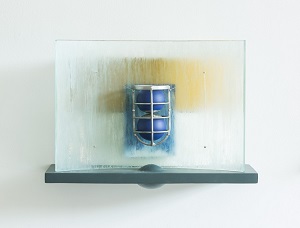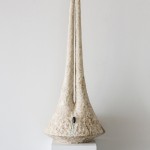Born Detroit, 1950 / BFA, Eastern Michigan University; MFA, University of Michigan / Lives in Ann Arbor, MI
Tom Phardel—sculptor, ceramist, and curator; beekeeper and bonsai enthusiast—has long played a critical role in the Detroit art community as both an artist and a supporter of other artists, and of course of the ceramic tradition. Serving as (much beloved) teacher and chair of ceramics at CCS for thirty years, he has inspired successive generations of students while pursuing his own artistic path, a path that has led him to a body of work notable for its sense of mystery, spirituality, and devoted connection to the natural world.
Phardel’s curiosity about the magic of ritual, paired with a strong respect for spiritual practices, has been prominent in his mind and art ever since childhood, when his fascination with the intricate, mysterious ceremonies of the Catholic Church left an indelible mark on him. Inspiration from trips to far-flung countries such as Japan and India remain evident in his work many years later, including his fascination with bonsai trees.
Although he has been sculpting bonsai for around 25 years, Phardel is adamant that he is only a beginner. He is an attentive caretaker of a small yet captivating forest of bonsai (over 30 trees), many in their own handmade containers, and each one with a distinct personality. Phardel sees the meticulous pruning and shaping of the trees as consonant with his art practice, although he does admit it takes an added knowledge of horticulture to be successful. Many of his trees made their public debut in a 2014 exhibit at Detroit café and exhibition space Trinosophes.
Phardel is consistently busy, wanting to stay active and maintain his creative vigor. He is intent on rethinking and expanding his visual vocabulary in order to effectively convey his ideas and feelings about the connectivity between art and nature, and between human beings and the lessons proffered by the natural world. Working both within his previous wheelhouse as well as venturing outside his comfort zone, his objects embody strength, precision, and mystery. He also revisits and rethinks relationships between forms (circles, swelling curves, rectangles), materials (steel, clay) and space.
Tea Whisk and Boulder (2016) stands at the heart of his most recent work, a meditation on nature versus science. The whisk is a sleek proxy for the modernized world. Resembling an antenna or a space-aged listening device, it converses with the boulder (excavated by the artist), through a plate of glass. A slender elliptical opening in the glass is rimmed in gold, suggesting that any dialog passing through is highly valuable. Phardel waxes philosophical about the boulder: “I wanted to convey the idea that it (the rock) can teach us something. We think that we know everything but maybe we don’t.”
As if floating serenely above a thin sheet of brushed stainless steel, the rough-hewn Levitating Mountain (2016) reveals a rich gold leaf underside reflected on the mirrored surface. The labor-intensive creation of the petite mountain required multiple firings, which slowly built up the geologic history of the form with each trip to the kiln. The Space Between (2016) also features an undercut bottom and an exterior rich with texture, but the form itself is entirely different. Two long, slim, tube-like extrusions gracefully separate from the base, leaving an exquisite, impossibly thin slice of powerful negative space betwixt the duo.
In a departure from the earth tones of his previous work, Phardel has introduced blue and red, two vivid primary colors specifically selected for their importance in various global religions. In Red Bindu (2016), a wall-mounted relief, two circles merge to suggest a shape not unlike a cell undergoing mitosis, an expansion that represents the pure potential in everyone. The two-lobed aperture in the middle of the form evokes a darkened, “unseeable” inner space, redolent of mystery and intrigue. The fabricated steel of Red Bindu boasts a brilliant saturated surface consisting of over 30 coats of paint painstakingly sanded down between layers. Blue on Blue-The Couple (2016), meanwhile, features two blue spheres in a cage stacked one on top of the other. The place where they make contact is a cool burnished silver. The curved, acid-etched opaque glass rectangle lends the work a sense of obscure, time-worn mystery.
One of the artist’s main ambitions is to transport his audience to a contemplative, entranced state. “I want to make work that you want to be with, as well as look at,” Phardel explains. Though his cryptic, mixed media structures may sometimes feel intangible—as if the answer from the oracle is enticingly just beyond reach—as always, the aura of his imagery and the generosity of his spirit carry the day.
Heather Earnley, October 2017
Copyright Essay’d, 2017









